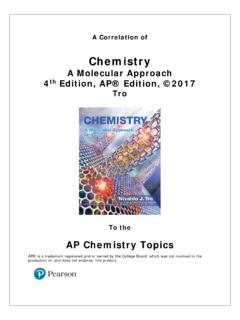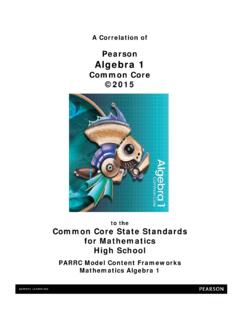Transcription of A Correlation of - Pearson School
1 A Correlation of Pearson algebra 1, Geometry, algebra 2 common core 2015 To the North Carolina High School Mathematics Alignment to Traditional Text - MATH II A Correlation of Pearson algebra 1, Geometry, algebra 2 common core , 2015 To North Carolina High School Mathematics Alignment to Traditional Text - MATH II Copyright 2014 Pearson Education, Inc. or its affiliate(s). All rights reserved. Introduction This document demonstrates how Pearson algebra 1, Geometry, algebra 2 common core Edition 2015 meets the standards of the North Carolina High School Mathematics Alignment to Traditional Text - MATH II. Correlation references are to the pages of the Student and Teacher s Editions, Concept Bytes, and Learning Resources within the Teacher s Editions. Pearson algebra 1, Geometry, algebra 2 common core Edition 2015 is a rigorous, flexible, and data-driven high School math program designed to ensure high School students master the common core State Standards.
2 The program s 5-step lesson design was built for the requirements of the common core , and independent research has proven the program s lesson design is effective for all learners. Pearson algebra 1, Geometry, algebra 2 common core Edition 2015 balances conceptual understanding, procedural fluency, and the application of mathematics to solve problems and formulate models. The lesson design of the program was built specifically to meet the rigor criterion of the common core State Standards. Each lesson begins with Interactive Learning, the Solve It!, which immediately engages students in their daily learning according to the Standards for Mathematical Practice. The second step of the lesson, Guided Instruction, uses visual learning principles and a Thinking/Reasoning strand (seen in the Know/Need/Plan and Think/Plan/Write boxes) to introduce the Essential Understanding of the lesson by teaching THROUGH and FOR problem-solving.
3 Interactive Learning and Guided Instruction are both deliberately designed to address the essential elements in the common core conceptual category of mathematical modeling. In the third step of the lesson, the Lesson Check, Do you know HOW? exercises measure students procedural fluency, while Do you UNDERSTAND? problems measure students conceptual understanding. In the fourth step of the lesson, Practice problems are designed to develop students fluency in the Content Standards and proficiency with the Mathematical Practices. Real-world STEM problems as well as problems designed to elicit the use of one or more of the Standards for Mathematical Practice are clearly labeled in the Practice step of the lesson. The final phase of the lesson, Assess and Remediate, features a Lesson Quiz to measure students understanding of lesson concepts. By utilizing the balanced and proven-effective approach of Pearson s 5-step lesson design, you can teach the common core State Standards with confidence.
4 A Correlation of Pearson algebra 1, Geometry, algebra 2 common core , 2015 To North Carolina High School Mathematics Alignment to Traditional Text - MATH II indicates modeling standards 1 (+) Standards needed for advanced courses such as calculus CB = Concept Byte SE = Student Edition TE Teacher s Edition common core State Standards for Mathematics Math II Concept(s) Pearson algebra 1, Geometry, algebra 2 common core , 2015 Rewrite expressions involving radicals and rational exponents using the properties of exponents. Convert radicals to exponential form using properties of exponents algebra 1 SE/TE: 418-421, 447, 448-450, 474-478, 480-482, 540-542, 720-722, 792-797 TE: 423A-423B, 452A-452B Geometry SE/TE: 1, 23, 79, 349, 399 TE: T889, T890 Use units as a way to understand problems and to guide the solution of multi-step problems; choose and interpret units consistently in formulas; choose and interpret the scale and the origin in graphs and data displays.
5 Use units to understand problems and guide solutions Choose units appropriately Interpret units in the context of a problem Choose and interpret the scale and origin in graphs and data displays algebra 1 SE/TE: 116-119, 122-123, 124-127, 152-156, 158-160, 228-230, 253-257, 283-286, 288-290, 480-482, 658-660, 732-735, 746-749, 786-790, 792-797 TE: 121A-121B, 129A-129B, 259A-259B, 737A-737B, 751A-751B Geometry SE/TE: 59-64, 70-74, 76-78 TE: 67A-67B Define appropriate quantities for the purpose of descriptive modeling. Define appropriate quantities for descriptive modeling algebra 1 SE/TE: 116-119, 152-156, 158-160, 178-181, 222-226, 228-230, 262-264, 283-286, 301-304, 353-356, 608-610, 738-742, 786-790 TE: 121A-121B, 183A-183B, 267A-267B, 306A-306B, 744A-744B A Correlation of Pearson algebra 1, Geometry, algebra 2 common core , 2015 To North Carolina High School Mathematics Alignment to Traditional Text - MATH II indicates modeling standards 2 (+) Standards needed for advanced courses such as calculus CB = Concept Byte SE = Student Edition TE Teacher s Edition common core State Standards for Mathematics Math II Concept(s) Pearson algebra 1, Geometry, algebra 2 common core , 2015 Choose a level of accuracy appropriate to limitations on measurement when reporting quantities.
6 Choose a level of accuracy within context algebra 1 SE/TE: 137-141, 144-148, 152-156, 228-230, 358-360, 387-390, 408-410 TE: 143A-143B, 150A-150B, 392A-392B Geometry SE/TE: 283, 291, 331, 339, 340 Interpret parts of an expression, such as terms, factors, and coefficients. Interpret parts of an expression algebra 1 SE/TE: 4-7, 10-13, 46-49, 68-72, 74-77, 228-230, 262-264, 274-278, 283-286, 308-311, 353-356, 512-515, 518-520, 523-526, 529-531 TE: 9A-9B, 15A-15B, 52A-52B, 267A-267B, 281A-281B, 314A-314B, 517A-517B, 522A-522B, 528A-528B, 533A-533B algebra 2 SE/TE: 288-293, 527-530 TE: 295A-295B, 533A-533B Interpret complicated expressions by viewing one or more of their parts as a single entity. For example, interpret P(1+r)n as the product of P and a factor not depending on P. Interpret the meaning of grouped together parts of an expression as a single entity algebra 1 SE/TE: 207-210, 222-226, 288-290, 523-526, 529-531, 535-538 TE: 213A-213B, 528A-528B, 533A-533B algebra 2 SE/TE: 41-45, 434-439, 442-447, 451-456, 527-530 TE: 48A-48B, 441A-441B, 450A-450B, 458A-458B, 533A-533B A Correlation of Pearson algebra 1, Geometry, algebra 2 common core , 2015 To North Carolina High School Mathematics Alignment to Traditional Text - MATH II indicates modeling standards 3 (+) Standards needed for advanced courses such as calculus CB = Concept Byte SE = Student Edition TE Teacher s Edition common core State Standards for Mathematics Math II Concept(s) Pearson algebra 1, Geometry, algebra 2 common core , 2015 Use the structure of an expression to identify ways to rewrite it.
7 For example, see x4 y4 as (x2)2 (y2)2, thus recognizing it as a difference of squares that can be factored as (x2 y2)(x2 + y2). Rewriting expressions by combining like terms, expanding and factoring algebra 1 SE/TE: 511, 523-526, 529-531, 535-538, 658-660 TE: 528A-528B, 533A-533B algebra 2 SE/TE: 216-221, 296-300, 361-364, 367-370, 374-378, 527-530 TE: 223A-223B, 302A-302B, CB 360, 366A-366B, 373A-373B, 380A-380B, 533A-533B Use the properties of exponents to transform expressions for exponential functions. For example the expression can be rewritten as ( )12t to reveal the approximate equivalent monthly interest rate if the annual rate is 15%. Use properties of exponents to transform expressions algebra 1 SE/TE: 460-466, 474-478 TE: 466A-466B algebra 2 SE/TE: 361-364, 367-370, 374-378, 381-385 TE: CB 360, 366A-366B, 373A-373B, 380A-380B, 388A-388B Understand that polynomials form a system analogous to the integers, namely, they are closed under the operations of addition, subtraction, and multiplication; add, subtract, and multiply polynomials.
8 Add, subtract and multiply polynomials algebra 1 SE/TE: 486-489, 492-494, 497, 498-501, 504-507, 535-538, 540-542, 608-610, 658-660, 720-722, 792-797 TE: 491A-491B, 496A-496B, 503A-503B, 509A-509B algebra 2 SE/TE: 280-285, 288-293, 296-300, 303-308 TE: 287A-287B, 295A-295B, 302A-302B, 310A-310B A Correlation of Pearson algebra 1, Geometry, algebra 2 common core , 2015 To North Carolina High School Mathematics Alignment to Traditional Text - MATH II indicates modeling standards 4 (+) Standards needed for advanced courses such as calculus CB = Concept Byte SE = Student Edition TE Teacher s Edition common core State Standards for Mathematics Math II Concept(s) Pearson algebra 1, Geometry, algebra 2 common core , 2015 Identify zeros of polynomials when suitable factorizations are available, and use the zeros to construct a rough graph of the function defined by the polynomial. Identify zeros from factored form Use zeros to sketch graphs algebra 1 SE/TE: 561-563, 603-606 TE: 566A-566B algebra 2 SE/TE: 288-293, 319-322 TE: 295A-295B, CB 325, 324A-324B Create equations and inequalities in one variable and use them to solve problems.
9 Include equations arising from linear and quadratic functions, and simple rational and exponential functions. Create and solve equations and inequalities in one-variable algebra 1 SE/TE: 53-56, 81-85, 88-91, 94-97, 102-105, 109-112, 124-127, 130-133, 171-174, 178-181, 186-189, 200-204, 207-210, 214-218, 691-695 TE: 58A-58B, 87A-87B, 93A-93B, 100A-100B, 108A-108B, 114A-114B, 129A-129B, 136A-136B, 177A-177B, 183A-183B, 192A-192B, 206A-206B, 213A-213B, 220A-220B, 697A-697B Geometry SE/TE: 323, 346-348, 439, 440-444, 480-482 TE: 447A-447B algebra 2 SE/TE: 26-30, 33-37, 41-45, 194-198, 226-229, 542-545 TE: 32A-32B, 40A-40B, 48A-48B, 201A-201B, 231A-231B, 548A-548B A Correlation of Pearson algebra 1, Geometry, algebra 2 common core , 2015 To North Carolina High School Mathematics Alignment to Traditional Text - MATH II indicates modeling standards 5 (+) Standards needed for advanced courses such as calculus CB = Concept Byte SE = Student Edition TE Teacher s Edition common core State Standards for Mathematics Math II Concept(s) Pearson algebra 1, Geometry, algebra 2 common core , 2015 Create equations in two or more variables to represent relationships between quantities; graph equations on coordinate axes with labels and scales.
10 Create and graph equations with two or more variables algebra 1 SE/TE: 60, 61-64, 262-264, 282-286, 301-304, 308-311, 315-318, 322-325, 353-356, 460-463, 546-549, 553-556, 573, 698-702, 713 TE: 66A-66B, 267A-267B, 306A-306B, 314A-314B, 320A-320B, 328A-328B, 466A-466B, 552A-552B, 558A-558B, 704A-704B Geometry SE/TE: 189, 191, 193, 197, 210, 257, 431, 467, 798, 800, 801 TE: T69, 196A, 204B, 803B algebra 2 SE/TE: 68-71, 74-78, 81-86, 92-96, 114-118, 134-138, 142-145, 202-206, 434-439, 442-447, 498-503, 507-512 TE: 73A-73B, 80A-80B, 88A-88B, 98A-98B, 120A-120B, 141A-141B, 148A-148B, 208A-208B, CB 232, 441A-441B, 450A-450B, 505A-505B, 514A-514B Represent constraints by equations or inequalities, and by systems of equations and/or inequalities, and interpret solutions as viable or nonviable options in a modeling context. For example, represent inequalities describing nutritional and cost constraints on combinations of different foods. Represent constraints by equations/inequalities and by systems of equations/inequalities Interpret solutions algebra 1 SE/TE: 37, 387-390, 394-397, 408-410, 596-599, 603-606 TE: 392A-392B, 399A-399B, 601A-601B algebra 2 SE/TE: 134-138, 142-145, 149-152, 157-160, 258-261 TE: 141A-141B, 148A-148B, 155A-155B, 162A-162B, CB 163, 264A-264B, CB 484 A Correlation of Pearson algebra 1, Geometry, algebra 2 common core , 2015 To North Carolina High School Mathematics Alignment to Traditional Text - MATH II indicates modeling standards 6 (+) Standards needed for advanced courses such as calculus CB = Concept Byte SE = Student Edition TE Teacher s Edition common core State Standards for Mathematics Math II Concept(s) Pearson algebra 1, Geometry, algebra 2 common core , 2015 Rearrange formulas to highlight a quantity of interest, using the same reasoning as in solving equations.

















